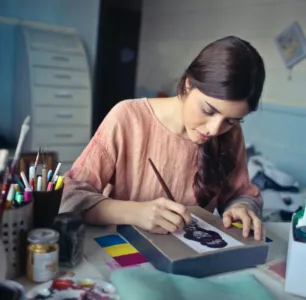Unlock the power of creative thinking with these 7 techniques for teenagers. Discover effective strategies to unleash your imagination and foster innovative ideas.
Are you a teenager eager to explore your creative side? Do you often find yourself looking for new ways to think outside the box and come up with unique ideas? If so, you’ve come to the right place! In this article, we will explore seven techniques that can help teenagers like you develop and enhance their creative thinking skills. So, let’s dive in and unlock the boundless potential of your imagination!
1. Mind Mapping: Visualize Your Ideas
Mind mapping is a powerful technique that can help teenagers organize their thoughts and generate new ideas. Start by identifying a central topic or problem and write it in the center of a blank page. From there, branch out and jot down related ideas, concepts, and solutions. Use colors, symbols, and images to make your mind map visually stimulating. This method allows your brain to make connections between different ideas, leading to unique and innovative solutions.
For example, let’s say you’re working on a school project about climate change. Begin by writing “Climate Change” in the center of the page, then branch out with subtopics like “Causes,” “Effects,” and “Solutions.” Further expand each subtopic with related ideas, statistics, and images. By visually representing the information, you’ll be able to grasp the bigger picture and identify creative angles to approach the subject.
2. Reverse Thinking: Challenge Conventional Ideas
Reverse thinking involves flipping conventional ideas upside down to gain fresh perspectives. Instead of following the usual thought patterns, try approaching a problem from an opposite viewpoint. This technique encourages you to question assumptions and break away from established norms.
For instance, if you’re tasked with designing a new product, think about its opposite function or purpose. How can you make something that does the opposite of what is expected? By challenging conventional ideas, you’ll uncover unique and innovative solutions that can set your work apart.
3. Random Word Association: Unleash Your Imagination
Random word association is a technique that can help teenagers tap into their creativity and expand their thinking. Begin by choosing a random word, either by using a word generator or picking one from a dictionary. Then, let your mind freely associate other words, ideas, or images that come to mind based on that initial word.
For example, if the word is “ocean,” your associations might include “waves,” “seashells,” “sand,” or even “mermaids.” The goal is to explore various connections and let your imagination flow. This technique helps break fixed thought patterns and stimulates the brain to make unexpected connections, leading to unique and creative ideas.
4. SCAMPER Technique: Boost Innovation
The SCAMPER technique is a creative thinking tool that provides a framework for generating innovative ideas by asking specific questions. Each letter in SCAMPER represents a different prompt: Substitute, Combine, Adapt, Modify, Put to another use, Eliminate, and Reverse.
Let’s take the example of designing a new board game. Using the SCAMPER technique, you could ask questions like:
- Substitute: What elements of existing board games can be replaced or exchanged with something new?
- Combine: Can different game mechanics or concepts be combined to create a unique gameplay experience?
- Adapt: How can existing game mechanics or rules be modified to fit a specific theme or setting?
- Modify: Can the rules or objectives of the game be altered to make it more challenging or engaging?
- Put to another use: How can the board game elements be repurposed for other activities or learning experiences?
- Eliminate: What unnecessary elements or rules can be removed to simplify the game without compromising fun?
- Reverse: What if the objectives or rules of the game were reversed? How would that impact the gameplay?
By employing the SCAMPER technique, you’ll be able to explore different dimensions of your ideas and push the boundaries of innovation.
5. Role-Playing: Stepping into Different Perspectives
Role-playing is not just for acting or gaming; it can also be a powerful tool for creative thinking. By assuming different roles or perspectives, teenagers can gain a deeper understanding of various viewpoints and explore innovative solutions.
For example, imagine you’re trying to come up with ideas for improving your school cafeteria. Take on the role of a chef, a nutritionist, a student, or even the cafeteria manager. Each perspective will provide unique insights and ideas. The chef might suggest new menu items, the nutritionist could recommend healthier options, the student might propose fun events or themes, while the cafeteria manager may focus on efficiency and cost-effectiveness. By exploring these different viewpoints, you’ll uncover a wide range of creative ideas to enhance the cafeteria experience.
6. Brainstorming: Collaborate and Innovate
Brainstorming is a widely known and effective technique for generating creative ideas. Gather a group of friends or classmates and set a common goal or problem to solve. Encourage everyone to freely express their ideas without judgment or criticism. The key is to generate a large quantity of ideas in a short period.
To make the brainstorming session more effective, set specific rules like “no idea is too crazy” or “build on others’ ideas.” This creates an open and supportive environment that fosters creativity. Remember, even the most outrageous ideas can lead to breakthrough solutions when combined or refined.
7. Divergent Thinking: Embrace Open-Ended Exploration
Divergent thinking is the ability to think outside the box and generate a wide range of possible solutions. Unlike convergent thinking, which focuses on finding a single correct answer, divergent thinking encourages exploration and multiple perspectives.
To enhance divergent thinking, engage in activities that promote open-ended exploration. Try writing short stories without predetermined endings, engaging in art projects with no set theme, or solving puzzles with multiple possible solutions. By embracing the freedom to explore different paths and ideas, you’ll nurture your creative thinking skills and unlock a world of possibilities.
Unleash the Power of Creative Thinking!
With these seven techniques, you can unlock the power of creative thinking and tap into your limitless imagination. Remember, creativity is not limited to artists or inventors; it’s a skill that can be nurtured and developed by anyone, including teenagers like yourself. Embrace these techniques, practice regularly, and watch as your creative thinking soars to new heights. Get ready to bring your unique ideas and innovations to the world!
How Rugby Can Foster Creative Thinking
Rugby is not only a physically demanding sport but also a game that requires strategic thinking, adaptability, and teamwork. Interestingly, playing rugby can also contribute to the development of creative thinking skills. Here are a few ways in which rugby can help foster creative thinking in players, including teenagers:
1. Decision-Making under Pressure
Rugby is a fast-paced sport that demands quick decision-making under pressure. Players need to assess the situation, analyze various options, and make split-second decisions on the field. This constant demand for making decisions in dynamic and unpredictable situations enhances players’ ability to think creatively and adapt their strategies on the go.
For example, a player might need to decide whether to pass the ball, kick it, or run with it based on the position of their teammates, opponents, and the overall game situation. This quick decision-making process develops their ability to think creatively and choose the most effective option in a given moment.
2. Problem-Solving and Strategic Thinking
Rugby involves solving complex problems during the game. Players need to strategize, anticipate opponents’ moves, and find ways to overcome obstacles on the field. This problem-solving aspect of rugby nurtures players’ ability to think creatively and find innovative solutions to overcome challenges.
For instance, players might need to devise new plays or tactics to break through a strong defensive line or find gaps in the opponents’ defense. This requires thinking beyond traditional strategies and coming up with creative solutions that catch the opposition off guard.
3. Improvisation and Adaptability
Rugby is an unpredictable sport where situations can change rapidly. Players must be able to adapt to unexpected circumstances and improvise when necessary. This adaptability fosters creative thinking as players learn to respond creatively to new challenges or opportunities that arise during the game.
For example, if a planned play or set piece doesn’t work as intended, players need to think quickly and come up with alternative solutions on the spot. This ability to think creatively and adapt to changing situations is a valuable skill both on and off the rugby field.
4. Teamwork and Collaboration
Rugby is a team sport that requires effective communication and collaboration among players. Creative thinking often flourishes in collaborative environments where ideas can be shared and built upon. Rugby provides teenagers with opportunities to work together with teammates, exchange ideas, and find creative ways to achieve common goals.
Teamwork in rugby involves developing innovative plays, coordinating movements, and exploiting opponents’ weaknesses. By engaging in this collaborative process, players enhance their creative thinking skills and learn to leverage the diverse perspectives and skills of their teammates.
5. Creativity in Attack and Defense
Rugby offers opportunities for players to express their creativity both in attack and defense. In attack, players can employ various strategies and movements to confuse the opposition and create scoring opportunities. Creative thinking allows players to anticipate and exploit gaps in the defense, invent new passing sequences, or execute unexpected kicks.
On the defensive side, players need to think creatively to disrupt the opponents’ attack and prevent them from scoring. This may involve innovative tackling techniques, strategic positioning, or unexpected interceptions.
6. Analytical Skills and Self-Assessment
Rugby encourages players to develop analytical skills and engage in self-assessment. To improve their performance, players need to analyze their actions, identify areas for improvement, and develop strategies to enhance their skills. This analytical approach helps players think critically and creatively about their own performance, enabling them to make adjustments and refine their techniques.
By reflecting on their strengths and weaknesses, players can find creative ways to enhance their overall game. This self-assessment process allows them to think creatively about their own development and seek new methods or approaches to reach their full potential.

